| Trip
to Verdun
So,
the
last few days I realized a dream
of mine that i had for the last three years: A trip to the ruins
of the battlefield of Verdun.
Verdun
was one of the longest, bloodiest slaughters of the first world
war. It took place in 1916, which is now about 90 years ago.
The
idea to travel there was inspired by an old picture from the
second world war, which was taken by our (now dead) neighbour of
my parents.
This
guy was a cook in the war and apparently he was stationed in
France and while being there, he took a picture of the Ossuaire,
the “Beinhaus”, which was a burial site of 150000 soldiers,
who couldn’t be identified after the war. The picture was a
grainy black nd white, showing a building that looked a lot like a
huge bunker but with a grenade shaped tower in the middle.

I
had no clue what it was, but I had a slight idea what to look for
and after a few weeks I finally found out, what and where it was.
Some more research and I read the story behind this building and
then started to gather more information about Verdun and the
Battle there. So my interes was piqued and I really wanred to go
there. Problem was always lack of funds or time, since only in
summer and fall all the buildings are accessible.
Now
that I had two days of vacation to spare, I decided it was time to
go there and see for myself.
The
car ride to it was adventurous to begin with. At some point I had
to leave the autobahn near the airbase Ramstein (yes, that’s
where the band has the name from, in the 80ies there was a
catastrophinc air show where planes crashed into bystanders,
killing 42 of them and wounding many others in a giant fireball of
burning kerosene) to go pee. When I did that, I heard in the
background expolosinons and gunfire from the nearby proving
grounds. Made me shiver, since this was the kind of battlenoice, a
participant of the Verdun battle would have hear on his way there.
Anyways.
On
the first day I checked out the Fort Douamont, which was mostly
devastated.
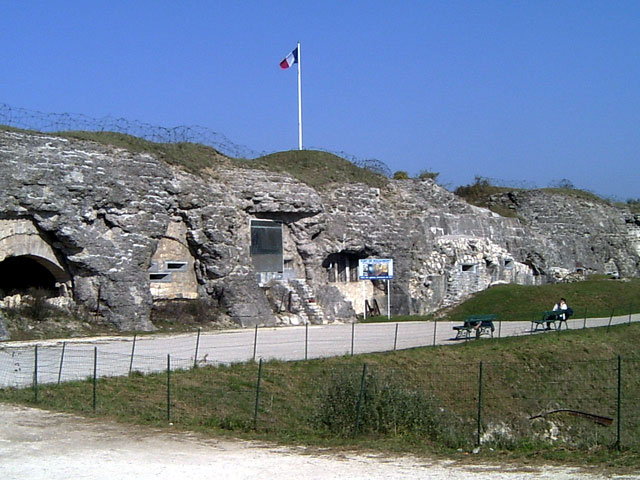
(Frontview of Fort
Douamont today. Notice the lighter colored rocks. This is where
grenades went through the roof and exploded inside the fort.)
I
couldn’t believe that 90 years after the war the landscape was
still *everywhere* a friggin crater landscape, it looked like the
moon – just in green. Grenadehole besides grenadehole and some
were of almost ridiculous size. Even the concrete, feet and feet
thick was penetrated in the fort. To know that almost 700000
people died on this tiny spot made my gag the whole day.
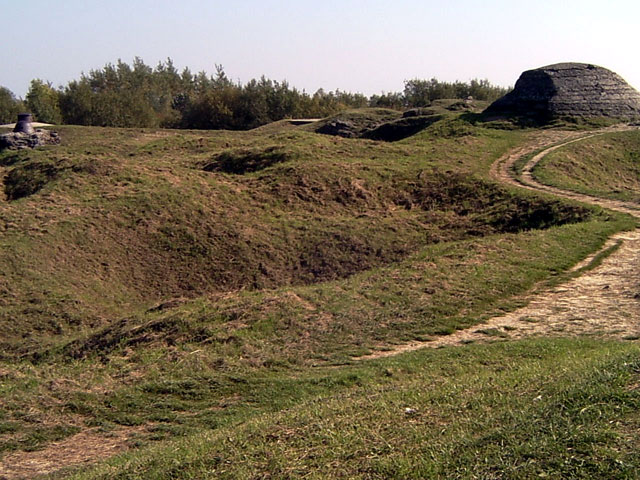
(On top of the
Fort. The fort was covered with a several meter thick layer of
earth. The craters shown here are about 2-5 Meters deep, twice a
mans size.)
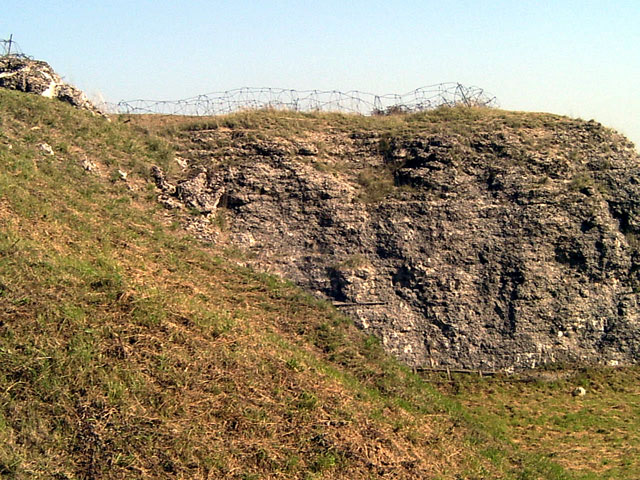
(Sideview of the
Fort. Notice the barbwire on top of it that has been there for 90
years now. Notice how crumbled the side looks. It had been hit by
hundreds (!) of grenades eating away more than two meters of its
concrete during the war.)
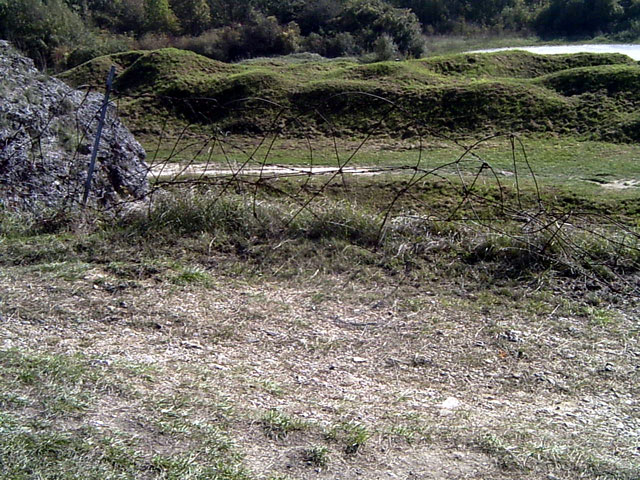
(Barbwire on top of
the Fort. Notice the big iron stakes that were used to hold it in
the ground. I almost stepped into one of them when i looked into
the forests later on.)
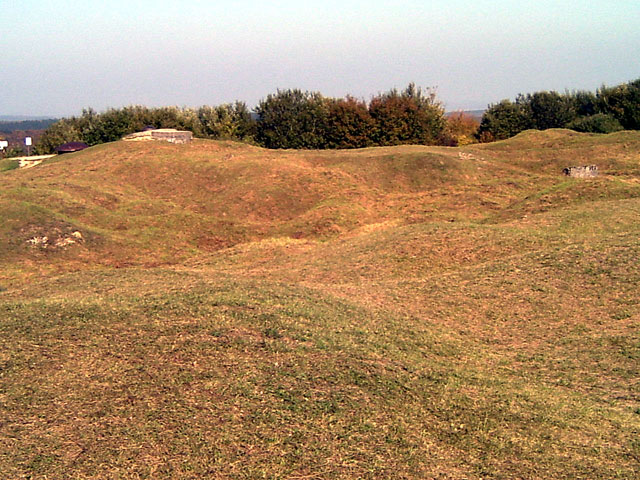
(On top of the Fort
still. Craters next to craters!)
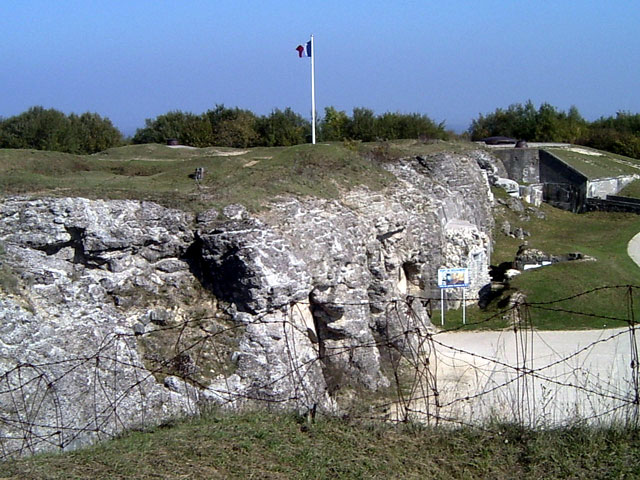
(View down to the
entrance of the Fort. I entered it and took some pictures inside.)
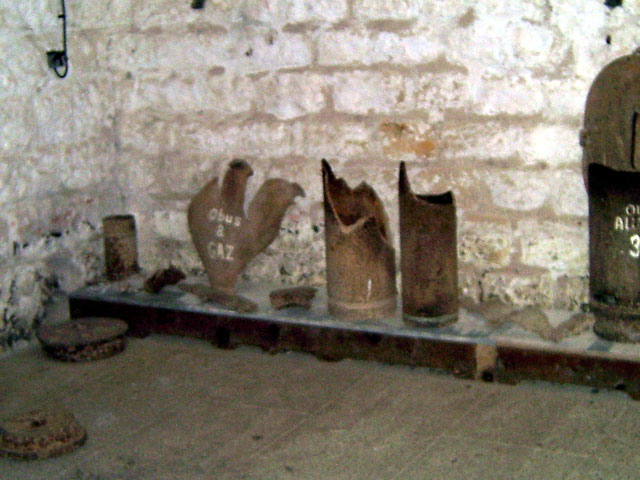
(Various exploded
shells. On the floor there are two old landmines. Notice one of
the shells that looks like anopened flower with petals. This was
one of the millions of gas shells they shot at each other.)
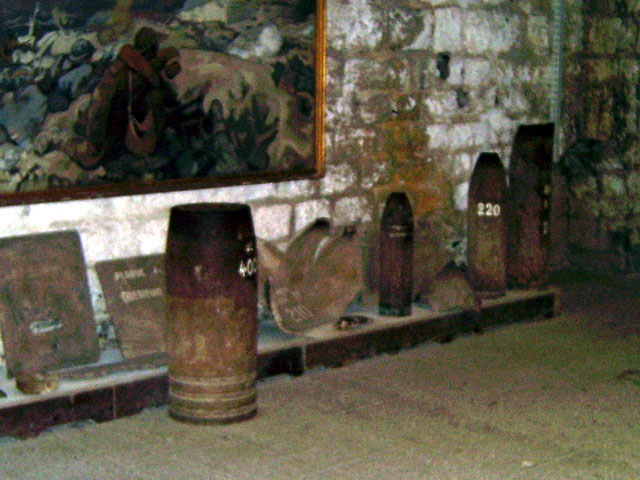
(More shells in the
same room inside the fort. Unfortunately most rooms inside were
too dark for my shitty digicam to take good looking pictures.
Forgetting my big flashlight while I was in this Fort didn't help
for sure either. The biggest shell you can see is 40cm calibre.
Huge and heavy - no chance for me to lift the empty shell when i
tried.)

(Here you can see a
walkway inside the Fort. This has been shot on a sunny day i nfall,
after a week without rain. It is incredibly wet in there in all
the rooms, so you can imagine how it must be in winter or after
rainfall.)
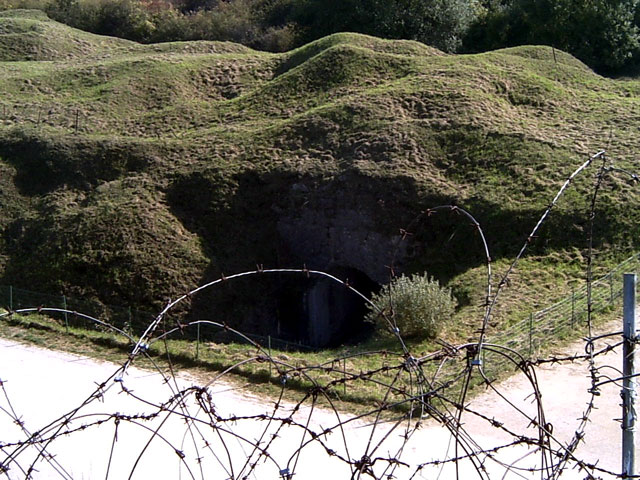
(Leaving the Fort,
view towards the forest in which I went to see a Bunker.)
After
taking pictures of the outside of the ruined fort and some of the
inside (just seeing the latrines, which were intended for 700
people but had to be used by 3500 made me cringe – 6 (six)
toilets for them with no running water – magine the stink. It
still smelled like death and decay in there!) I proceeded into the
forest to check out a small bunker nearby.

(South of the
bunker. This side was facing the french artillery batteries. It is
totally open towards that side, the bunker wall facing this way is
not existant at all anymore.)
I
had read about it before but seeing how tiny this thing was made
me scared. Hundreds tried during the battle to reach the safety of
this bunker. When I say it, I realized how devastated they must
have been, when they finally arrived there. While the walls and
ceiling was still there, the front side was totally opened by
gunfire, exposing the occupants to enemy fire. There was *no
shelter to be found in it, literally a death trap.
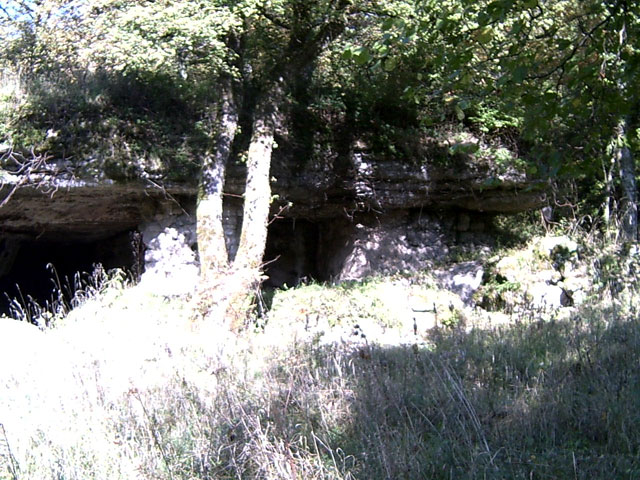
(Horribly
overexposured, same Bunker. Not a single tree inthis forest is
older than 80 years. It took the French dozens of years to clear
the landscape from mines and shells so you can at least get to
most of these places now. There are still lots of unexploded
shells in the ground, so leaving the trail was always dangerous.)
On
the way to the Ossuaire, I checked out a part of a long trench
that still exists. This trench was providing the french with a way
to connect the Froideterre area with the Fort Douamont and the
city of Verdun itself without being totally exposed to the german
artillery fire.
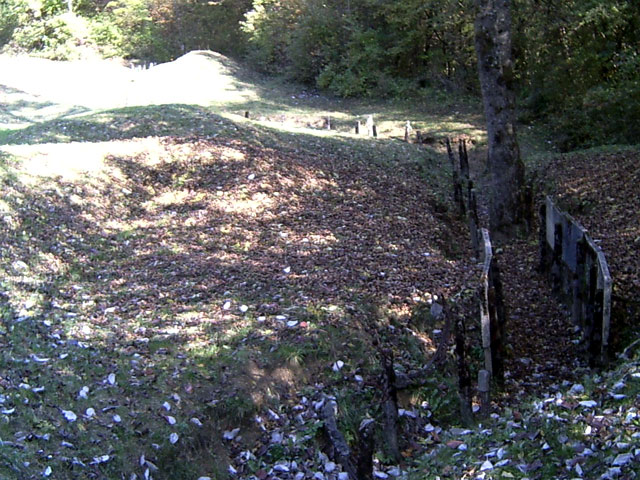
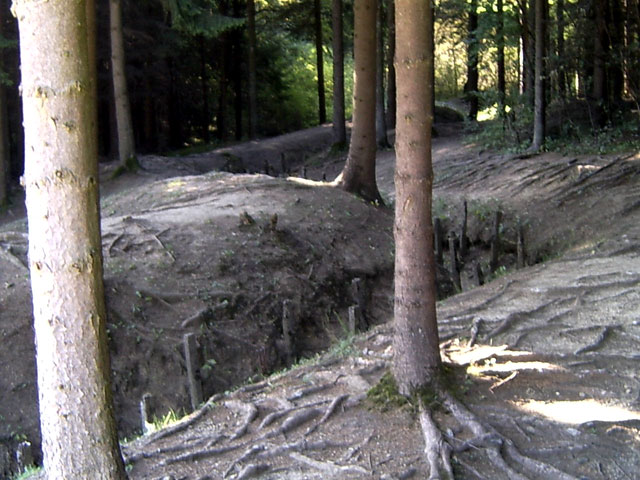
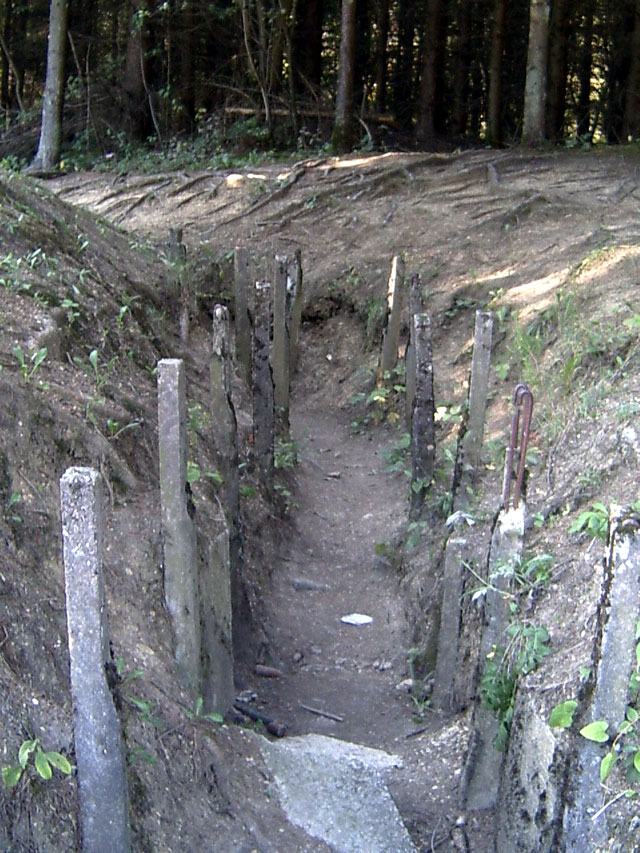
(The concrete
pillars were used to hold concrete plates onthe sides of the
trench to stabilize it. It was common for the trenches to cave in
and bury soldiers in them. After 90 years this trench is only half
as deep as it used to be.)
Then
I went to check out the Ossuaire, the very reason to get here. Amazing,
the construction was futuristic and brutal, I totally liked it.
With its bunkerlike features nothing else would have been more
suitable to function as a memorial.
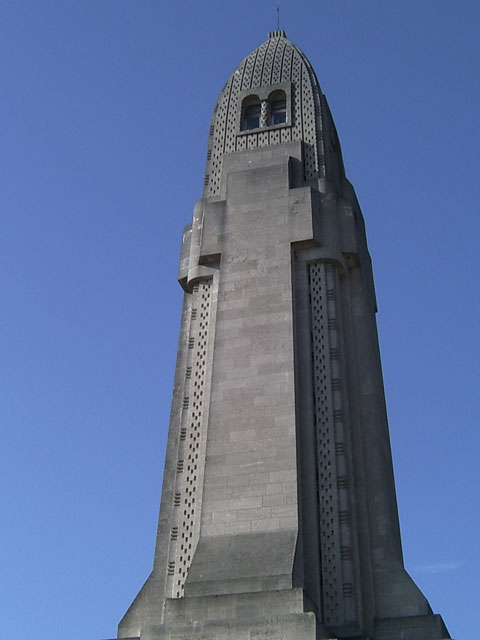
(Bullet shaped
clocktower.)
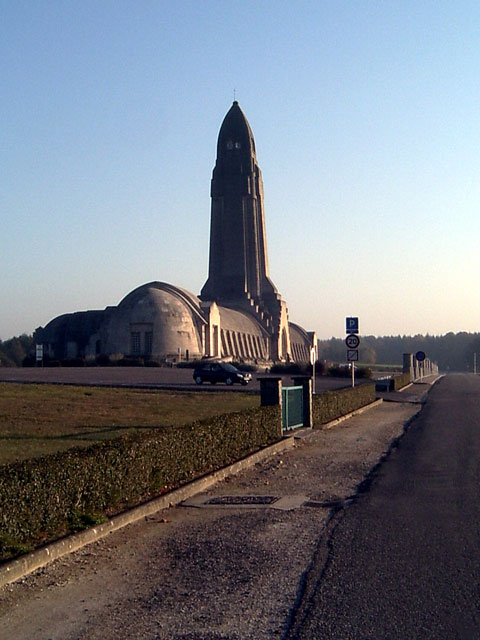
(The Ossuaire in
full view. Yes, that is my car in front of it.)
This is why I did
this trip. I was awed. 80 years after it was built, 60 years
after my dead neighbor saw it, I did now too.
In
front there are the graves of 15000 people.
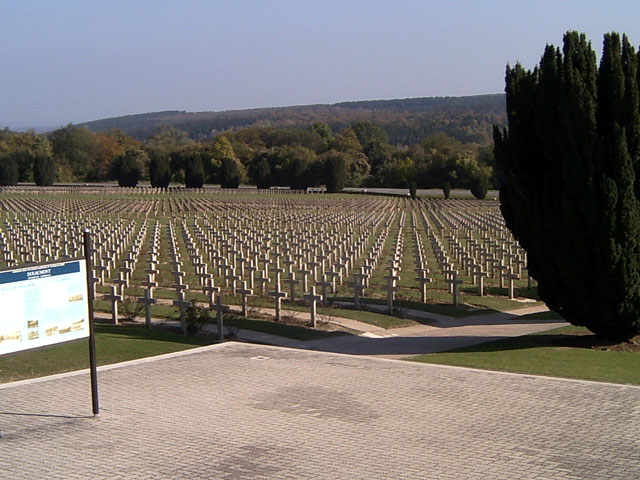
The
look on this huge amount of crosses and stars (Muslim symbols were
also present) made me feel very
mortal. I’m very glad that we’re not having a war of this
scale since 50 years now.
I
met a French couple then on my way to Thiaumont, which was left in
the state it was after the war. Whatever I thought before of
crates next to Douaomiont, Thiaumont topped it.
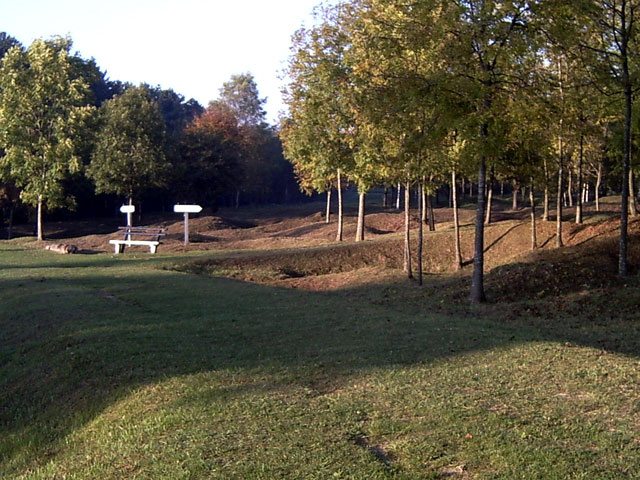
It was just hole
next to hole, in a hole next to even bigger holes.
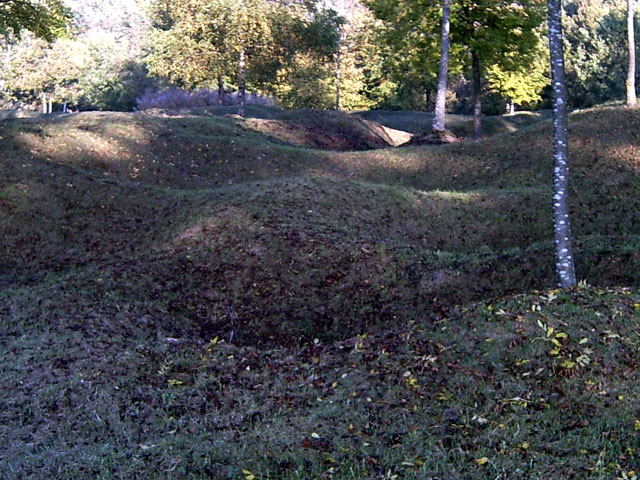
In the middle
two small concrete slabs – which were the remains of bunkers
again that soldiers headed for. If they arrived there, they must
have again seen that they gve no shelter whatsoever anymore.
Unbelievable enough, in this small (I was surprised how small and
confined the battlefield was!) space every squaremeter had a dead
soldier in it during the battle. Every single one.
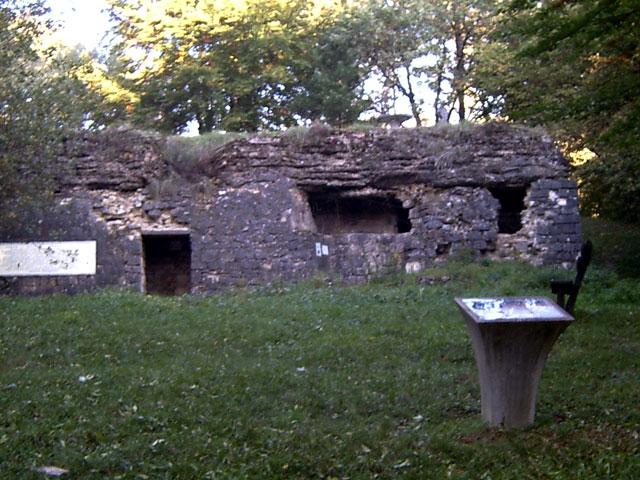
(This is the Bunker
from Thiaumont that is in better shape, meaning its ceiloing did
not cave in entirely. Here you can see the front of the Bunker,
how it would have looked for the first one too, that was blown
open all the way.)

(Inside the Bunker,
parts of the ceiling caved in. The rusty metal is sharp edged, so
entering the Bunkers is *dangerous*. Most bunkers are fenced off
and feature warnings on not to enter them.)
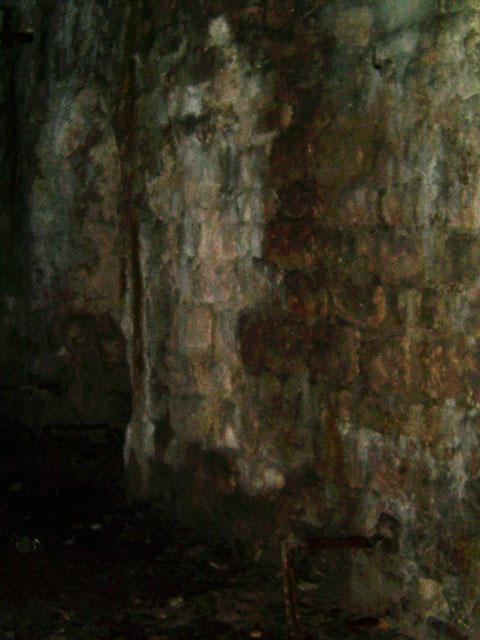
(Blind shot into
the dark. My flashlight was way too weak to brighten the Bunker
inside enough and so i took a quick snap inside with the flash on.
Everything is really wet inside and full of rusted metal, so
walking in there proved difficult.)
I
returned to my car and checked out another fort, Fort Vaux. Smaller
than Douamont it was also a very bloody battle there. I took pictures of
the inside and outside and was shocked how little of its outer
armament survived.

(Front view of the
Fort Vaux.)
I climbed on top of
the Fort. Again there were huge craters on top of it. Between them
were the small metal domes that housed observers during the battle.
If closely inspected you saw metal tracings on top of them that
looked like a shity broad welding job. In fact this was traces of
huighe grenades the bounced of the bunkers leaving the metal so
hot, that it started to melt, resulting in the welding looking
scars.

(Observer domes
between craters. On the left you can see the uncovered concrete
ceiling of the Fort.)
There was a huge metal armor outside, that used
to be a 30ton hull for a gun turret.
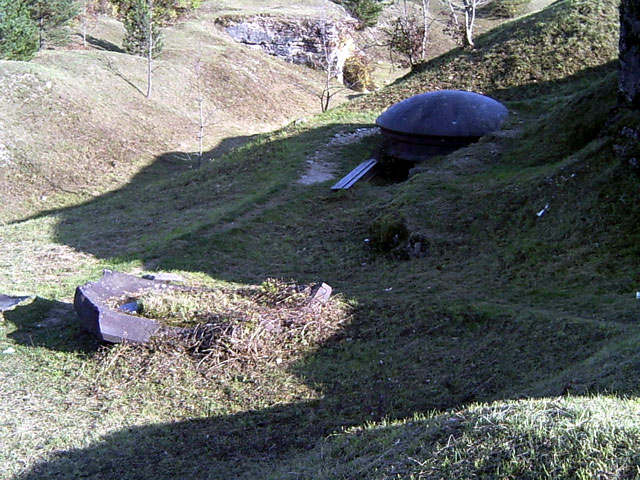
It
was blown to pieces. One can only imagine the forces released on
this to cause such distruction.

(75mm french
cannon in its firing position at the Fort Vaux.)
I proceeded into
the Fort to explore the inside. Once again my shitty digicam
had huge problems to work in the dark. This Fort is a bit better
lit than Douaumont, but still too dark to take good pictures.
Sorry.
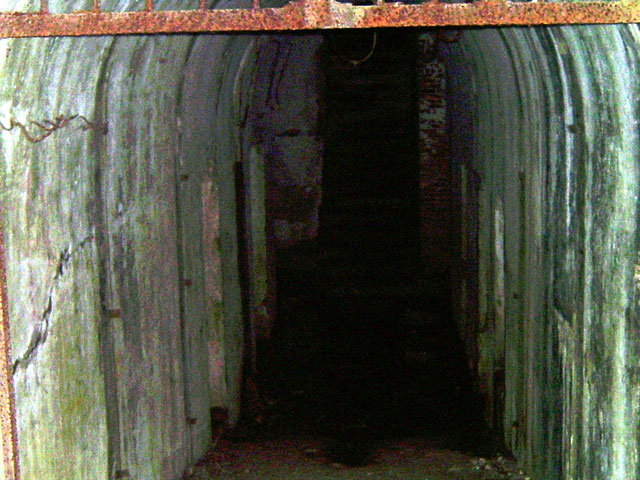
(Walkway
down into the Fort. Wet!)
I
checked out the Fort, it was similar to Douaumont. This one had
worse documentation though and not much signs inside to tell what
was what. I had a book with me that explained most sites I visited
so i consulted this.
After
a long day i decided that the setting sun was a sign to find some
rest, so i drove through Verdun to find a Hotel. I found a cheapo
Formula One hotel that provided my laptop and digicam with power,
me with a reasonably comfortable bed - and the only thing it
lacked was a cold beer from a vending machine or so. Plus all the
stores closed very early, so i only had my two Hansa bottles with
me that i chilled in the sink with cold water. Oh well. I watched
a documetary on my laptop (TV was i nfrench only) and then after
calling Tia i fell asleep.
The
next morning i woke up with sore feet from all the walking, did my
bathroom routine and then had a quick breakfast there. Oustide of
the hotel there were two guys who asked, where i was heading. When
i mentioned the village of Vauqois.
Apparently
they also travedled here to explore the bunkers before, since they
mentioned, that i wouldn't be able to see the tunnels there. Hm.
Alright, but i was this time more curious to see the hilltop
anyways.
But
before Vauqois i wanted to see Froideterre, where also a Fort was
still to be found. And this proved to be a very exciting visit for
me.
Größere Kartenansicht
Froideterre
When
I drove to Froideterre, i passed by Souville. There were not many
remains to be seen, however I figured i'd go for it anyways. After
a few minutes of walking a muddy forest trail, I was at the former
fort. This one was much smaller than the other ones, and most of
it was gone.
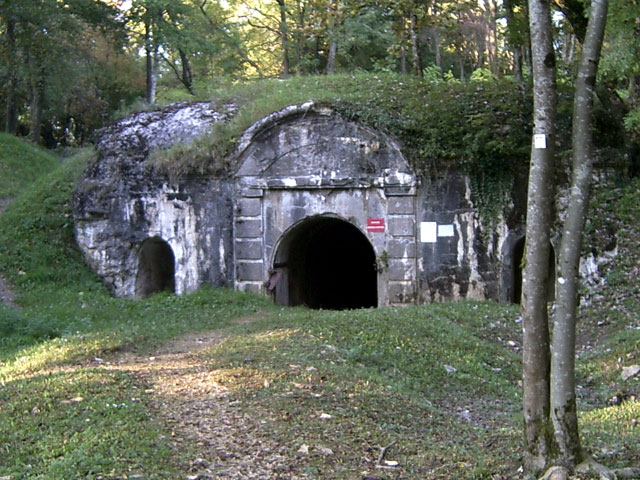
(The
entrance of the Fort. It only leads to two fenced of rooms and an
artillery turret, which is on top of the bunker.)
I
tried entering it, but it was fenced off, so there was not much to
do about that. There was a fortified position just on its left,
but the top of the Bunker was caving in and it looked horribly
unstable, so i refrained from entering it without a hard hat and
others around.
So I went to Froideterre.
Arriving
there in the early morning meant that there were no visitors
present. It was very silent and i noticed how scary the forests
around the bunker system are. The early sunlight casted long
shadows over the bunkers and I started to take pictures of the
outside of the Fort.
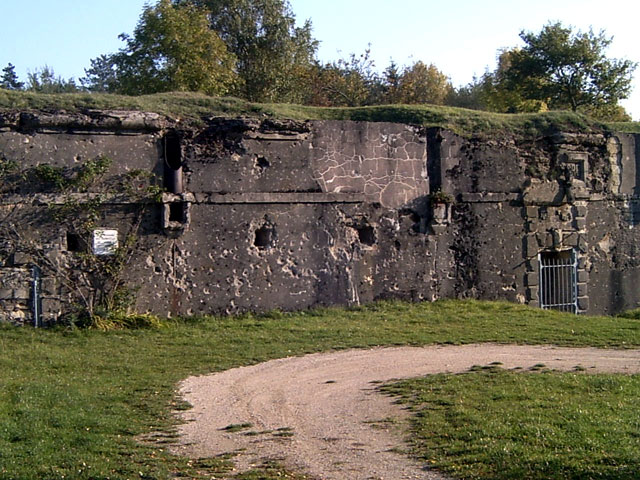
(Pockmarked
outside of Froideterre. You can see the fenced doors leading into
the Fort. It is easy to spot, that lots of machinegun bullets were
fired at the small windows of the Bunkercomplex.)
As
always i climbed on top of the Fort first and saw a machine gun
turret in almost perfect condition. These turrets could get
erected to fire at the approaching troops and then get lowered
again to be safe from grenade attacks etc. I soon found out how
this works.

(Machinegun
turret on top of the Fort.)
I
proceeded to walk around the Fort when i noticed that the area
below the turret looked accessible. And there it was: An open door
leading into the Bunker under the gun turret. A sign reads "Danger.
Defense d'entrer" Well. I don't speak much french anymore so
i decided to ignore the sign, since the door was invitingly open.
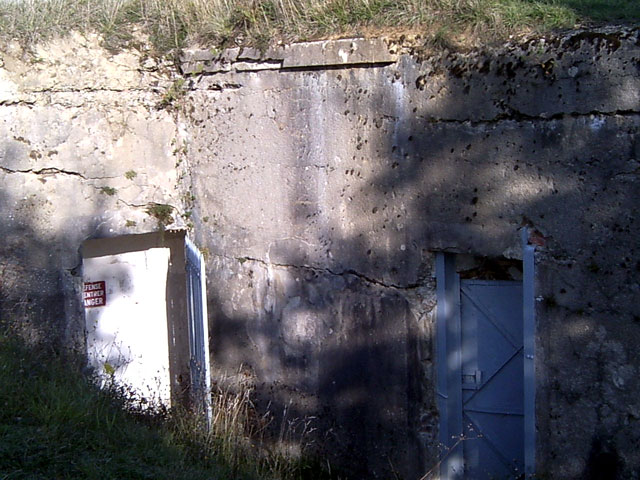
(Open
door to the turret bunker.)
After
entering it, i saw an interesting metal construction in front of
me. This is the lifting mechanism to raise and lower the turret!
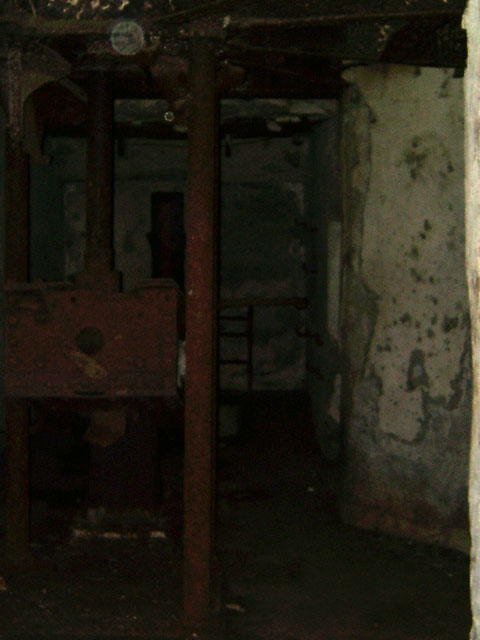
(The
rusty hydraulic mechanism to operate the turret. Sorry for the bad
quality.)
There
was a ladder to climb on to the top where the gunner was sitting,
but the bent stairs and the partially broken steps convinced me
that it would not be safe to get up there.
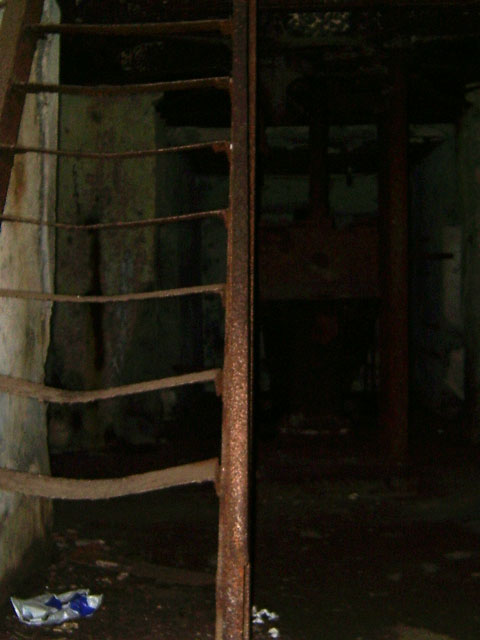
(Broken
ladder leading up to the turret.)
So
I went to a different part of this bunker and found a sideway,
that lead to a way more stable looking ladder. This one i would
climb :)

(This
ladder leads to a machinegun turret too. Much better condition!)
On
my way up i felt a breeze going through the bunker. The wind
started to howl when it passed through the creaks of the bunker,
breaking on the turrets and the labyrinthlike walkways inside.
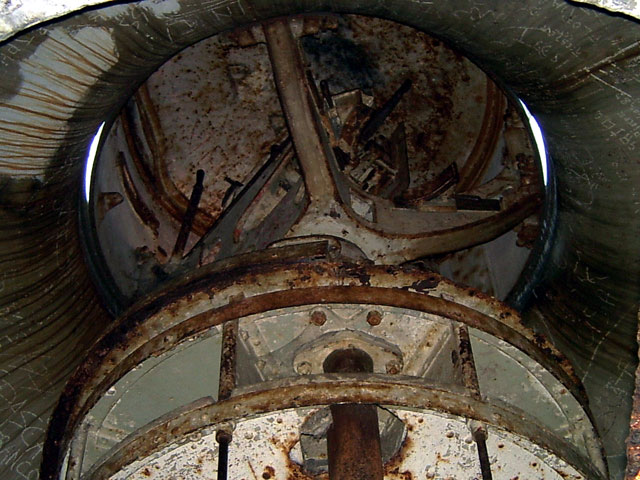
(The
machinegun holder in the turret.You can see the handcrank on the
left side of the picture that was used to elevate and lower the
machingun itself.)
There
was very little room left to climb up into, especially since there
was a wooden floor in the turret that looked horribly unstable
already. So i could only take a quick picture up there while i
held myself up on the top stair of the ladder.
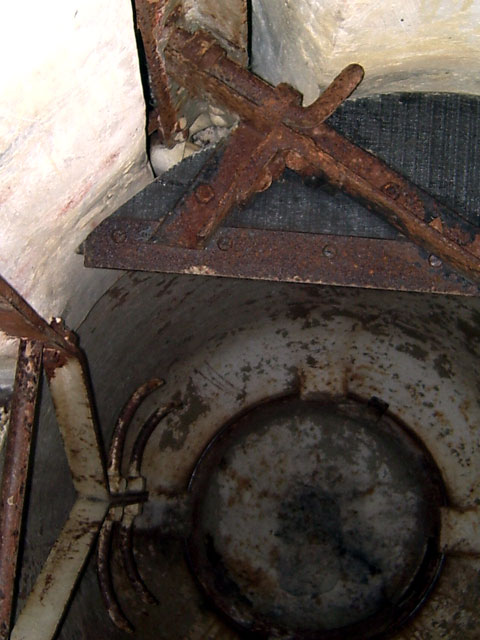
(The
top of the turret. I really wanted a fisheye objective now for my
digicam. Crap.)
On
the way out and into the main complex i took a quick picture of
the gun mounts they had in there.
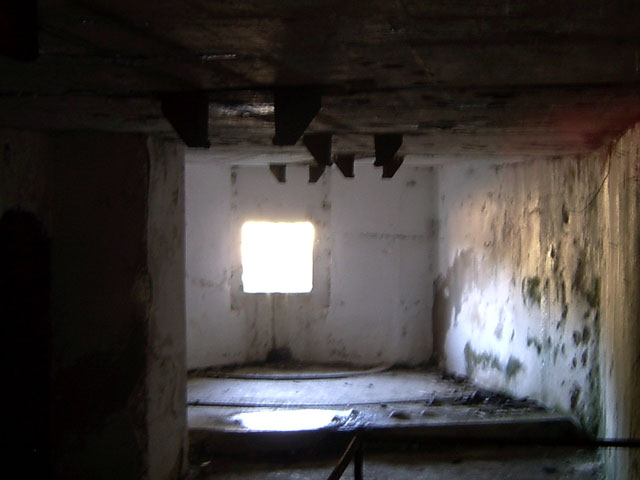
(Blurry,
I know. The hooks on the ceiling held a track that was used to
carry grenades between the ammo dump and the gun itself. You can
see the tracks of the gun on the ground still.
I
entered the main complex where the pockmarked windows were.
Strange enough, the door here was also open. It was totally unlit
in there ans all I had was a small flashlight. I felt woefully ill
equipped to explore the Bunker. Anyways, I travelled inside. But
without much light this was very difficult. At one point i ran
into this here, dangling from the ceiling:
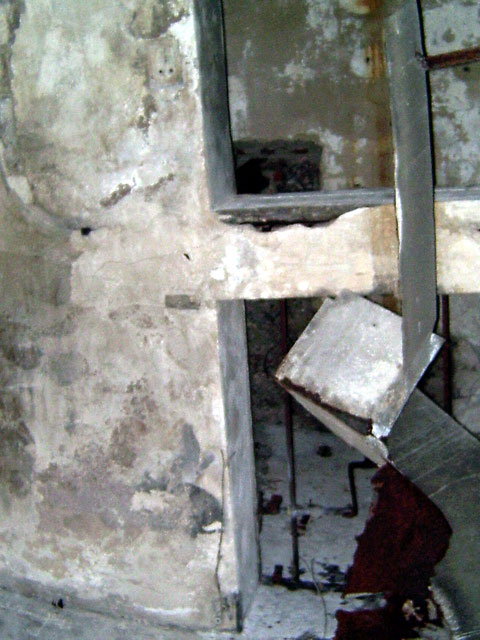
(friggin
big metal sheet that I hit head front. Ouch. What looks like
windows is actually a door and a window on top of it, that they
used to have more air going through the bunkers. The small rooms i
nhere were partially rebuilt into sleeping rooms for the soldiers,
so some walls went only up to two thirds of the height to the
ceiling.)
After
this i wanted to see if i could get to a guntower underground from
here. It was race against time, since the small flashlight i had
started to fade rapidly. With no other light i tried to make it,
stumbling thorugh the wet and moist bunker. Not having a plan of
it i felt like in "Scare tactics" or this other show on
MTV where they send Teenagers to do missions in old abandoned
buildings with no lights. Well MTV: Send them here, *i* was scared
shitless with the wind howling through the bunker, weird dripping
sounds everywhere around me and a serious lack of light.
When
i entered the next big room to see how the ceiling was giving in,
i gave up for this time to get to the turret.
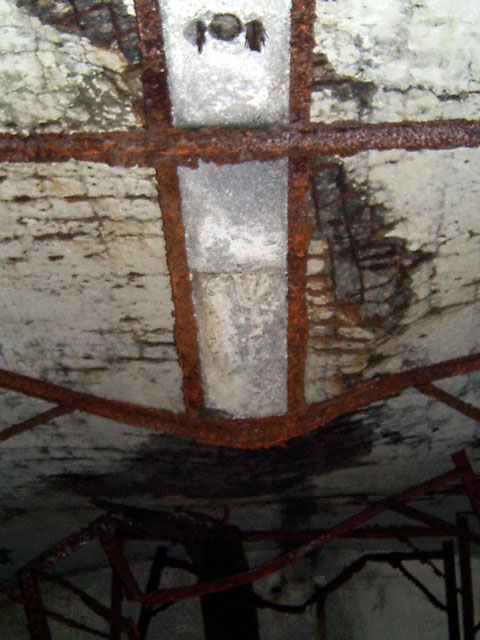
(Notice
how the concrete is broken and only held up by the totally bent
steel. Especially in the background you can notice how twisted the
metal there is. This room had been hit on top with a 40cm calibre
shell, that almost broke through.)
I
stumbeld back to the entrance, now almost in total darkness since
the flash was out. I went faster and faster, being scared a lot
and realizing that if i get stuck in here it could take hours
until somebody shows up since this is not one of the more
frequently visited bunkers. Plus i don't think someone would
expect a visitor being inside of them really, since they are
usually closed by the doors.
But
I managed to get out, breathing heavily. I got back to my car and
calmed down a bit. I decided to get to Vauquios next and see the
Mort homme hill on the way of possible.
A
short ride withthe car later i found a french bakery and got me
some hot coffee. That cured the last remains of fear i still had
from Froideterre and i was prepared for a little walk through the
forest on top of the Mort Homme.
This
is where the germans got stuck in the first worldwar - they never
reached a closer point towards Verdun than this very trench you
can see in the picture.
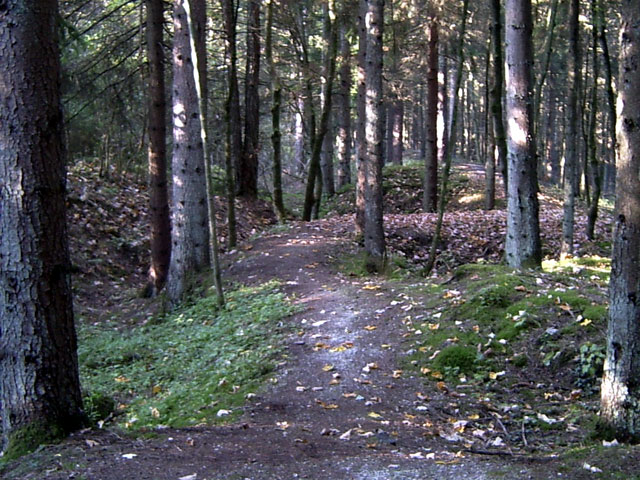
(Hard
to notice, but the left side of the trail is the front trench of
the germans. On the right side you can see the zigzag construction
of the trench, that was used to make it more difficult to conquer
the trench once enemy troops got in it. The germans used
flamethrowers in such cases since the fire would follow the
zigzags without problems, and being confined into the trench would
be able to get much further than outside of it.)
I
followed a path through the woods for more than half an hour and
was shocked, how close the trneches were to each other. They were
barely out o f throwing distance of hand grenades, so every
attempt to break into the others side trench was suicidal at best.
Downhill towards the german held side of this hill you can still
make out the trench that was used to get the wounded out and
reinforcements and ammunition and food in.
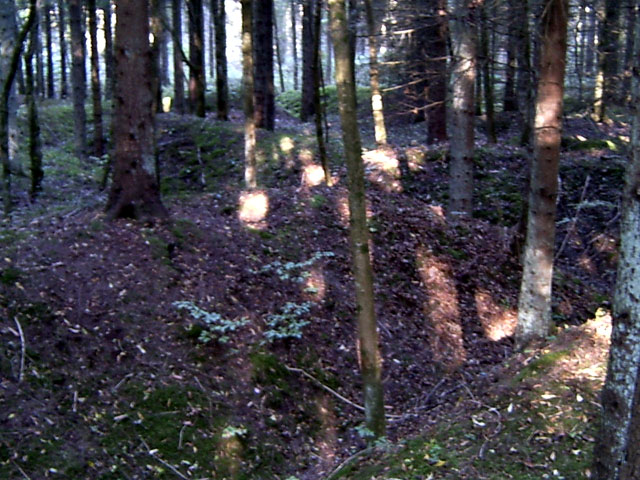
(Another
bad picture, but the zigzag of the trench is easy to spot.)
Next
I went to the village of Vauquois, or what is left of it. This
village was literally blown up by both sides. When it was captured
by the germans they could only get half of it in their hands with
the french being on the other side. Neither side could win, and
after the artiellery blew up all the houses both sides dug
themselves in and was even more impossible to overcome.
So
they started to dig tunnels into the hill under the enemys
position and blew up huge amounts of explosives, creating gigantic
craters on the surface and burying the miners of the other side,
that were also buildig tunnels in the hill. Both sides blew more
than 100 charges over the years, effectively taking the top 20
meters of the hill and leaving craters that are very deep.
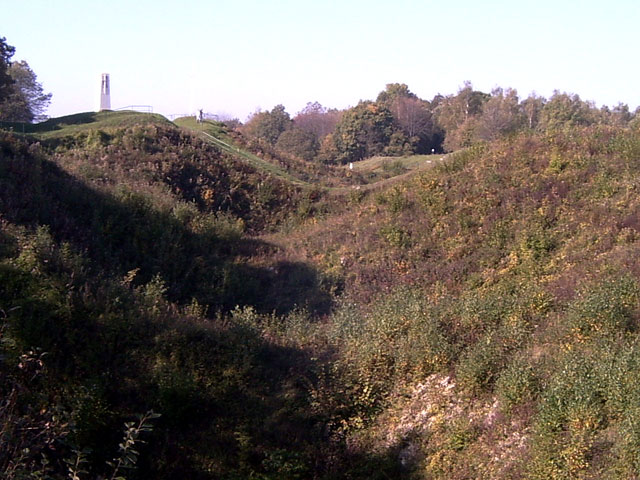
(Craters
in Vauquois, you can see on the left and right where the hill
still curves up. This is about 20-30 meters of hill missing in the
middle!)
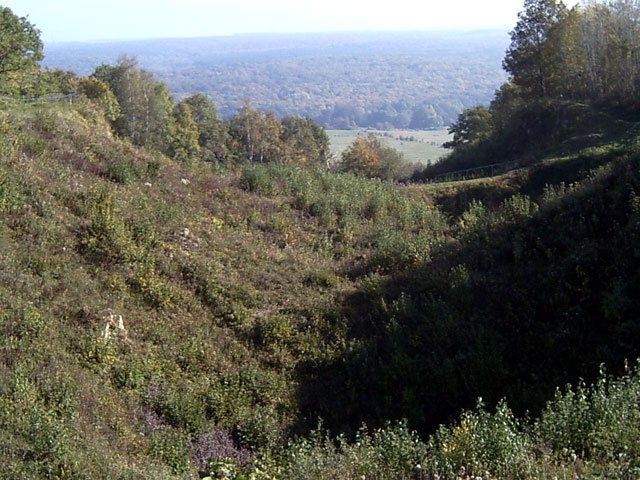
(Looking
down into the valley of Verdun. You can barely see the ledge of
the walkwas in the middle. Notice how huge these craters are!)
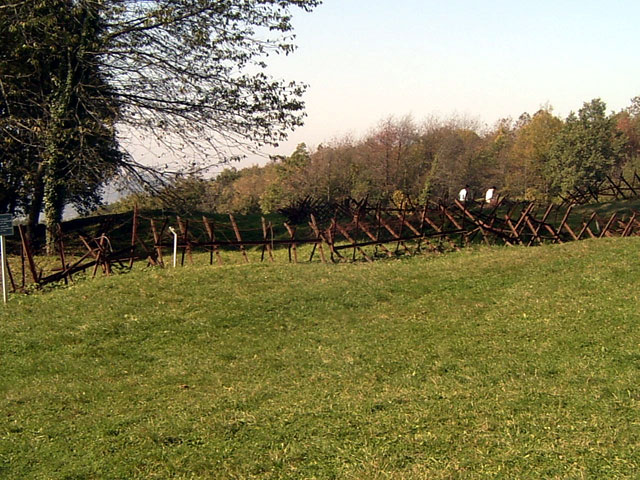
(Barbwire
construction on top of the hill. No chance to get through here.)
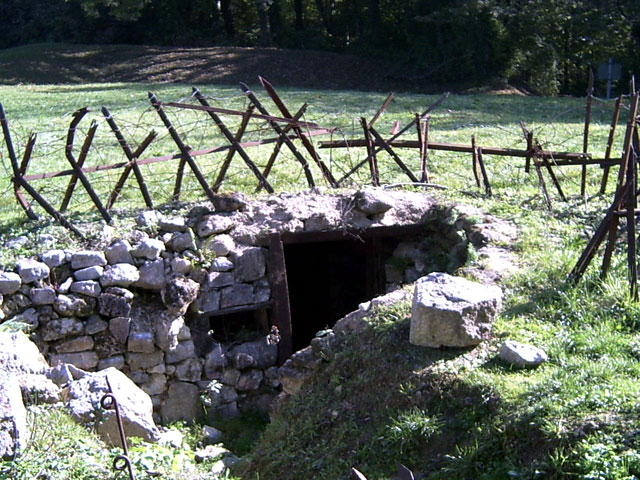
The
entrance to the french tunnel system. It is impossible to get down
there without proper equipment and lacking flashlight, hard hat
and proper clothing plus being on my own i decided to take a peek
into it, but not enter the system. Next timei want to take the
guided tour there though!
After
this i went back to Verdun, checked out the museum and the ruins
of Fleury behind the museum (my cameras memory was full) and then
head back home. I think i will return here at some point to see
the things i could not this time. but better equipped and with a
sidekick :)
|